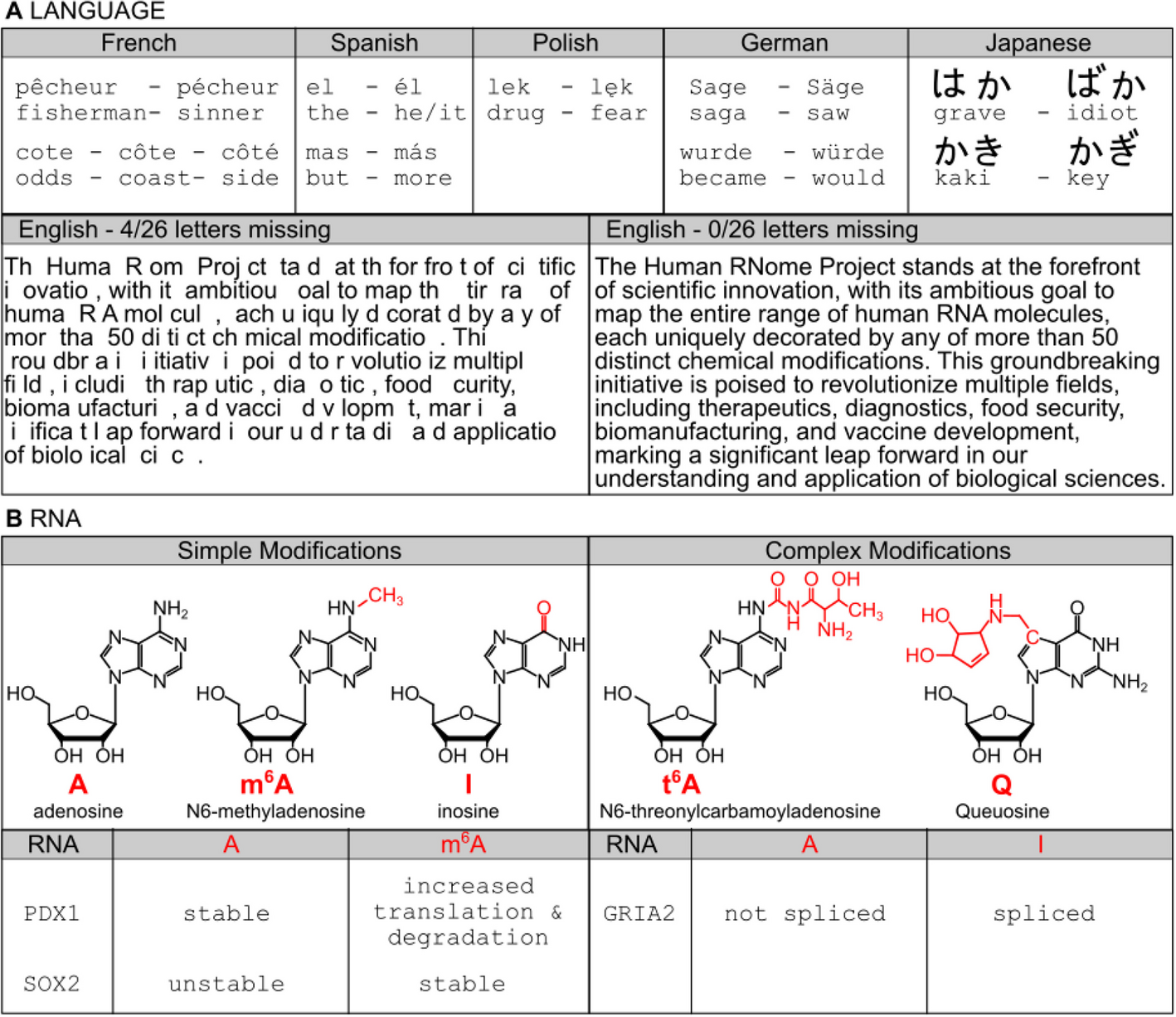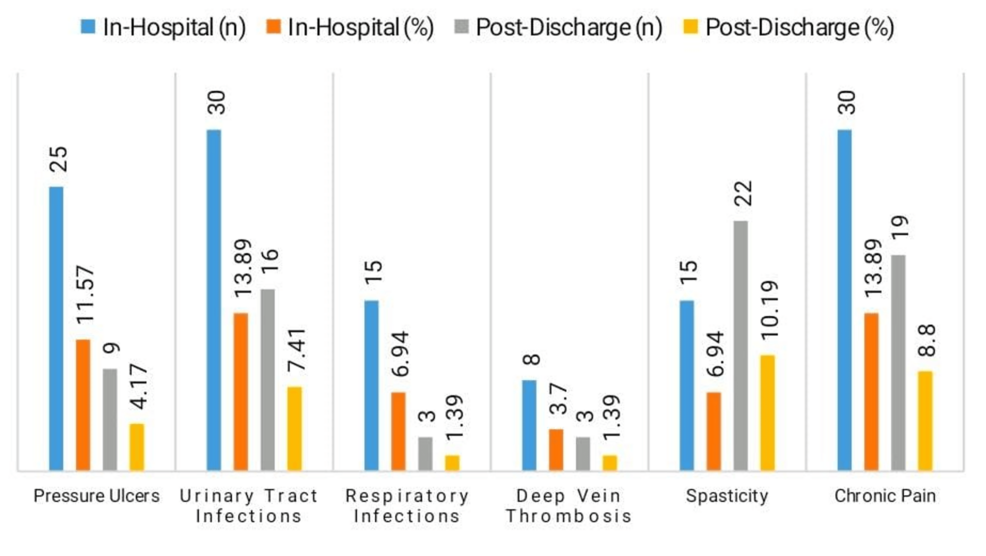- In ‘Mistress Dispeller,’ a Story as Old as Time (With a Very New Twist) The New York Times
- In cities across China, there’s a special kind of consultant you can hire if you find out your spouse is cheating. They’re called “mistress…
Author: admin
-
In ‘Mistress Dispeller,’ a Story as Old as Time (With a Very New Twist) – The New York Times
-

Selena Gomez celebrates ‘In the Dark’ debut with mom
Selena Gomez proved that some…
Continue Reading
-

The U21 Cricketers in the Quaid-e-Azam Trophy
Red-ball cricket has long been considered the true test of a player’s skill, temperament, and character. For Pakistan, a nation with a proud yet turbulent cricketing history, the future of its Test setup depends heavily on how well it…
Continue Reading
-

Unlocking the regulatory code of RNA: launching the Human RNome Project | Genome Biology
The Human RNome Project aims to ensure consistent and reproducible outcomes in RNA sequencing and modification studies by utilizing standardized cell lines maintained under uniform culture conditions. This standardized approach will facilitate meaningful comparisons across technologies and laboratories. The selected cell lines will be widely accessible, easy to maintain in culture, and highly proliferative, ensuring an adequate supply of RNA for sequencing and characterization experiments. Importantly, these cell lines will exhibit genetic stability, characterized by a well-defined genome with minimal mutations and chromosomal aberrations, to guarantee the reliability and robustness of the generated data.
To maintain genomic integrity, cell lines will be sourced from certified distributors at regular intervals and used at low passage numbers (< 8). Genetic integrity will be independently verified through DNA and cDNA sequencing, with results reported alongside direct RNA sequence data. This ensures that any genomic drift is identified and accounted for in downstream analyses.
Table 1 lists cell lines that meet these criteria. These lines have been extensively characterized by large-scale studies such as the ENCODE Project [25, 26] and the 1000 Genomes Project [17, 18]. For instance, GM12878, a cultured B-cell line from a female donor with ancestry from Northern and Western Europe, has been sequenced as part of the 1000 Genomes Project and characterized by ENCODE. IMR-90 lung fibroblasts, BJ foreskin fibroblasts, and H9 human embryonic stem cells are similarly well-characterized and available through trusted sources like Coriell, ATCC, and WiCell, which will also enforce standardized protocols for culturing and handling. Given the sensitivity of RNA to environmental factors, these standardizations are critical for ensuring data comparability. Repositories will also require users to follow consistent protocols for culturing and RNA extraction, as variations in these processes could influence RNA sequence and modification profiles.
Table 1 Cell lines for initial steps of the Human RNome Project RNA extraction and quality control: RNA will be extracted using a guanidinium thiocyanate-based method to ensure high purity and integrity. RNA quality will be assessed by absorbance ratio (260/280 and 260/230 nm) and capillary electrophoresis (e.g., Agilent TapeStation), requiring a minimum RNA Integrity Number (RIN) of 9 for RNA extracted from cell lines (as the project advances, and RNA samples are extracted from tissues, a lower RIN threshold such as 8 may be necessary). Aliquots of RNA will be archived for validation and further analyses.
Initial RNA targets for sequencing: The pilot phase of the Human RNome Project will focus on sequencing transfer RNA (tRNA), ribosomal RNA (rRNA), and mRNA, with a focus on selected protein-coding transcripts. These RNA classes are ideal initial targets due to their ubiquity, existing knowledge of their modification profiles, and robust expression across cell types.
tRNA and rRNA
tRNA (~ 250 expressed isodecoders) and rRNA (5S, 5.8S, 18S, 28S) are universally expressed and highly conserved, with well-studied modification types and locations [12,13,14]. Table 2 lists examples of modifications typically found in human mRNA, tRNA, and rRNAs. Both total tRNA and rRNAs can be purified from total RNA using electrophoresis or size-exclusion chromatography [28], while affinity-based methods such as chaplet chromatography [29] or reciprocal circulating chromatography [30] can be used to enrich for specific tRNA sequences. One drawback of all RNA purification methods is co-purification of non-target RNAs due to similar size or hybridization to target RNAs. Mass spectrometric analysis of modified ribonucleosides in purified RNA must always be viewed with suspicion for modifications found in multiple forms of RNA (e.g., m6A, m5C).
Table 2 Known modifications in rRNAs and tRNAs as internal validations Coding genes and their mRNAs
Selected protein-coding genes include ACTB, CDKN2A, ISG15, and SOD1. These genes were chosen based on their known association with diseases, moderate to high expression levels, relatively short transcript lengths (~ 1 kb), and known modifications. For example, SOD1 is associated with amyotrophic lateral sclerosis [31], while ACTB is widely expressed and associated with dystonia (Table 3).
Table 3 Protein-coding genes selected as representative RNAs to begin direct RNA sequencing Coding RNA enrichment methods: To detect low-abundance modifications, enriched RNA samples are critical. Initial poly-A RNA enrichment can be achieved using oligo-dT kits from various vendors [33]. For specific RNAs, biotinylated antisense oligonucleotides allow ~ fivefold enrichment [34], while microbead-based antisense oligos are claimed to achieve a 100,000-fold enrichment [35]. DNA nanoswitches offer another option, with ~ 75% recovery and purities exceeding 99.8% for RNA ranging from 22 to 400 nts [36].
Future goals
Short-term
-
1.
Standardized RNA extraction using guanidinium thiocyanate.
-
2.
Enrichment of test RNAs using antisense-based methods.
-
3.
Mass spectrometry-based direct RNA-seq for short-read identification of modifications and nanopore sequencing for long-read sequencing and modification mapping.
Medium-term
-
1.
Sequence transcriptomes from cell sorting-enriched samples of defined cell types.
-
2.
Compare data with existing programs (e.g., GTEx).
-
3.
Expand sequencing to include different cell types and tissues from individuals of all ages and ethnicities.
Long-term
-
1.
Sequence RNAs from specific subcellular regions (e.g., nucleus, cytoplasm, mitochondria).
-
2.
Integrate single-cell transcriptomic and subcellular data.
Source molecular resources and standards
The Human RNome Project relies on robust molecular resources and chemical standards to develop and validate sequencing and mass spectrometry (MS) technologies. These resources encompass synthetic and native RNA standards, as well as their building blocks, such as ribonucleosides, ribonucleotide triphosphates (NTPs), and oligoribonucleotides. High-quality standards are essential for ensuring accurate analysis of RNA modifications, their chemistry, and their precise locations within RNA molecules.
Chemical standards
Chemical standards are indispensable for training and validating analytical methods before analyzing native RNA samples. They ensure reproducibility, correct identification of RNA modifications, and calibration of detection systems. Standards are summarized in Fig. 2 and include the following.
Fig. 2 Overview of types of chemical standards needed for the Human RNome Project
Ribonucleosides and dinucleotide caps
Chemical standards for individual ribonucleosides are essential for characterizing RNA modifications and quantifying their abundance. Approximately 90 ribonucleoside standards are commercially available, with additional variants synthesized by academic laboratories. Comprehensive lists of vendors are provided on the RNome website [33], while PubChem offers detailed vendor information and links to chemical resources. Prices for these standards range from $20 to $1500 per milligram, with custom synthesis for rare modifications costing between $10,000 and $20,000. For qualitative analysis, 1 mg of a standard is typically sufficient. For quantitative analysis, we recommend assessing the purity of the standard by quantitative NMR prior to preparing calibration solutions for, as an example, LC–MS analysis. Despite the availability of over 90 modified ribonucleosides, many human-specific RNA modifications remain inaccessible as commercial standards. Furthermore, the chemical stability (shelf life) of ribonucleosides is not well-documented. For example, m1A undergoes Dimroth rearrangement to m6A during RNA processing and storage in aqueous solution [37, 38] highlighting the need for further research into ribonucleoside stability.
Ribonucleotide triphosphates
Ribonucleotide triphosphates (NTPs) are essential for in vitro transcription to synthesize RNA molecules longer than 20 nucleotides with defined modification profiles. Canonical NTPs are widely available from commercial sources, including isotopically labeled variants, while modified NTPs for specific ribonucleosides can also be obtained. However, these modified NTPs require rigorous verification of their chemical identity and purity, typically through techniques such as thin-layer chromatography (TLC) or LC–MS [39, 40]. In vitro transcription allows random, but not site-specific incorporation of modified NTPs [41].
Synthetic oligonucleotides and phosphoramidites
Site-specifically labeled RNA oligonucleotides, ranging from 5 to > 60 nucleotides, are essential for training nanopore base callers and validating LC–MS methods. Solid-phase chemical synthesis is commonly used to produce labeled oligonucleotides and vendors typically provide mass spectra to confirm the overall product length, failure sequences, and impurities. However, comprehensive validation, such as mass spectrometric sequence verification and ribonucleoside LC–MS for modification identification, is rarely included but essential for robust validation. To ensure accuracy, researchers must advocate for detailed validation data, including MS sequence validation and ribonucleoside-specific quantification, alongside the standard mass spectra provided by vendors. Despite these advancements, the site-specific incorporation of modifications into long RNA sequences (> 60 nucleotides) remains a significant challenge [42]. Current approaches, which involve combining chemical synthesis, transcription, and ligation, are labor-intensive, low yielding, and not easily scalable. New approaches to long RNA synthesis are needed to facilitate the generation of site-specifically modified RNAs that mimic biological molecules.
Future goals
Short-term
-
1.
Stability data for modified ribonucleosides is scarce, highlighting the need for systematic studies on shelf life.
Medium-term
-
1.
Consistent preparation, validation, and distribution protocols are essential to ensure data comparability over time. Quality control samples must be maintained and shipped with detailed documentation.
-
2.
Researchers should demand comprehensive validation data (e.g., MS/MS, sequence confirmation) from vendors to avoid errors in downstream analyses.
Long-term
-
1.
Sequencing and MS methods must be regularly validated using both synthetic and native standards
-
2.
High-quality library of modifications with comprehensive validation data and shelf-lives. Many RNA modifications lack synthetic standards, necessitating collaboration with organic chemists for their production.
Develop advanced sequencing technologies
Sequencing technologies will be pivotal to the Human RNome Project, much like they were for the Human Genome Project. To evaluate the potential impact on the project, it is essential to analyze the current state and project developments over the next 5 to 10 years. The consortium has hence identified and discussed lead questions that concern the type of currently available sequencing technologies, the necessary developments in the near future, and critical quality controls.
Current state of sequencing technologies
Current methods to map modifications can be classified into direct, such as mass spectrometry or direct RNA sequencing, and indirect, which usually relies on sequencing by synthesis, wherein RNA is converted to cDNA via reverse transcriptase [16]. Both indirect and direct RNA sequencing methods require additional steps to assign modifications. This section is meant as a brief summary and not a comprehensive review of all current variations and developments (for a comprehensive review please refer to the Report by the National Academies of Sciences, Engineering and Medicine [23]).
cDNA-based sequencing
Sequencing of cDNA, acquired through reverse transcription of RNA and analyzed through Illumina (and sometimes PacBio or Nanopore), is currently the most widely used form for indirect RNA sequencing. However, it cannot directly detect non-canonical ribonucleotides. Workarounds to map modifications rely on changing the RNA or cDNA product on a molecular level (“molecular input”) and include reverse transcriptase-based error profiling, chemical or enzymatic derivatization, and modification-specific immunoprecipitation [43, 44]. Molecular input methods utilize computational algorithms that infer RNA modifications from misincorporations, gaps, or reverse transcription arrests or reverse transcription incorporation of structurally similar bases. While powerful, no single molecular input method can comprehensively identify all modifications, necessitating the use of multiple techniques on the same RNA sample.
Direct RNA sequencing
Oxford Nanopore Technologies is the only widely available platform currently providing protocols for direct, long-read sequencing of RNA molecules, eliminating the need for cDNA conversion and preserving endogenous or synthetic exogenous RNA modifications (Fig. 3) [45,46,47,48]. Advances in machine learning models have led to more accurate basecalling and lower error rates for sequencing full-length native RNA transcripts [47]. By analyzing unique changes in electrical currents from the direct RNA sequencing process, RNA modifications can be tentatively identified [48]. Identification of modified nucleotide residues can be achieved by comparison against unmodified control samples [49], with base-calling algorithms or supervised models that have been trained on data with known modifications [47, 48, 50]. The training of such models can be achieved using data from cDNA-based approaches, data from modification-free control samples [49], in vitro transcription-generated data, or data from synthetic RNAs. However, the generation and availability of such data and the lack of RNA modification standards still limit the number of modifications that can currently be confidently detected and identified. Furthermore, not all reads from direct RNA-seq correspond to full-length RNAs and challenges remain to detect RNA modifications that occur at the 5′ ends of RNA molecules. To overcome these barriers, researchers are actively developing “molecular input” approaches—such as introducing chemical or enzymatic treatments which change the RNA molecule—to amplify or clarify the signals associated with RNA modifications [51].
Fig. 3 
Overview of the sequencing workflow that will allow end-to-end sequencing of RNA including its modifications
Mass spectrometry (MS)
Mass spectrometry (MS)-based RNA sequencing is an essential complement to these efforts as a means to chemically identify and accurately quantify specific modifications [52,53,54,55]. Unlike the chemically nonspecific interpretation of electrical signals in nanopore sequencing, MS-based sequencing involves high mass accuracy (i.e., exact molecular weight) determinations of modification fragments that allow structural identification of the modification, its location in the RNA sequence at single-nucleotide resolution, and its abundance in the population of RNA sequences. While MS sequencing requires larger quantities of RNA than NGS or nanopore sequencing, advances in sensitivity have moved the application from more abundant non-coding RNAs to mRNAs [55,56,57,58]. The major limitation of MS-based RNA-seq is the short fragment size needed for accurate MS analysis, typically 10–60 nt in length depending upon the mass resolution of the instrument [55]. This precludes mapping modifications in long native RNA molecules, as can be achieved with nanopore. MS-based RNA sequencing and nanopore sequencing are thus complementary tools for RNome analysis.
Quality control: ensuring the accuracy of modification-aware sequencing and analysis
The accuracy of epitranscriptomic analysis is determined by the combined impact of errors introduced during experimental procedures and data processing. To ensure high-quality data, experimental design must include an adequate number of replicates, sufficient sequencing depth, and the incorporation of both positive and negative controls. Method-specific data analysis should employ robust statistical frameworks to evaluate the significance of signals at specific sites, accounting for sample size, signal strength, and their relevance within the broader context of all samples, including replicates and controls. Given the diversity of current modification mapping methods, it is challenging to recommend a universal set of parameters for experimental design and data analysis. Therefore, we outline guidelines based on general principles in the following sections.
Conventional sequencing errors and “molecular input” errors
Base-calling accuracy in Illumina sequencing data typically has an error rate of 0.1–0.5% per nucleotide residue, while nanopore sequencing has only recently reduced its error rates to the single-digit range. While these error rates are not typically a major concern for conventional RNA sequencing, they become critical when using molecular input methods that depend on errors for mapping modifications, as these methods can introduce artifact-based errors, such as false positives and false negatives. To ensure data validity and reliability, it is essential to include a sufficient number of both biological and technical replicates, as well as adequate sequencing depth to optimize the signal-to-noise ratio. The significance of a detected signal is further strengthened by comparisons with positive and negative controls, ideally including at least one of each that represents a “gold standard” or ground truth.
Data interpretation
Quality control (QC) parameters are essential at multiple levels, including raw data (e.g., fastq files used for downstream analysis) and the analytical pipelines used for mapping modified residues. For raw data, QC criteria can often follow established standards for the respective sequencing technology, such as a Q-score > 30 for Illumina sequencing. The thresholds, however, may vary depending on whether short-read or long-read sequencing technologies are employed. Beyond this, a second layer of QC is needed to evaluate the performance of molecular input methods, which introduce their own characteristic errors. A third layer of QC pertains to computational analysis, assessing the reliability of data interpretation across different epitranscriptomics mapping protocols and pipelines. In some cases, it may be valuable to integrate these QC layers into aggregated error rates or composite metrics that encompass both molecular and computational aspects.
To advance the field, it is imperative to establish a universally accepted set of QC parameters for benchmarking methods. Equally important is the determination of standardized threshold values for these parameters, which could become mandatory for the Human RNome Project. The diversity of existing technologies, as well as those that will emerge during the project, complicates the establishment of universal QC criteria at the raw data level. However, any method must undergo rigorous validation before being deemed suitable for modification calling.
Validation should involve the creation of models evaluated with metrics such as receiver operating characteristic (ROC) curves, area under the curve (AUC), sensitivity (true positive rate), and specificity (true negative rate). Particular attention must be given to minimizing false positive and false negative rates, as these directly impact the reliability of modification detection. Another critical input parameter for these models is an accurate estimate of the expected number of residues for a given modification, as this will influence thresholds for modification calling. Such an integrative and standardized approach to QC will ensure robust and reliable results across diverse epitranscriptomic applications.
Establishing clear guidelines for reporting QC metrics in publications and data repositories is essential for fostering reproducibility and confidence in results. Comprehensive reporting of raw data quality, molecular input performance, and computational reliability will enable consistent practices across studies. Such transparency not only ensures accountability but also facilitates meta-analyses and comparisons, accelerating progress in the field.
Vision 2025: strategic steps for the next decade
Advancing modification-aware RNA sequencing on an international scale requires both organizational and technical developments. One of the greatest challenges will be achieving consensus within the field on a mandatory set of QC parameters and, even more challenging, establishing universally applicable threshold values. As highlighted earlier, in addition to maintaining a continuously updated overview of methodologies, the field must identify techniques that either deliver the highest throughput with minimal error rates or enable precise quantification of modification levels at specific RNA sites. With these considerations in mind, we outline the following ongoing and future objectives for the Human RNome Project.
Future goals
Short-term
-
1.
Continue developing NGS, nanopore, and MS technologies to (a) expand the repertoire of modifications for NGS and nanopore by developing and refining chemical derivatization methods; (b) expand training datasets and algorithms for nanopore; and (c) increase the sensitivity, LC resolution, and data processing algorithms for MS-based sequencing.
-
2.
Integrate orthogonal technologies (e.g., combinations of methods providing different molecular inputs or alternate sequencing technologies) to confirm RNA modifications with high confidence on native RNAs.
-
3.
Develop and implement robust quality control (QC) protocols for NGS, nanopore, and MS to (a) minimize artifacts, (b) increase statistical power, (c) increase sequencing depth, and (d) assure inter-laboratory consistency.
-
4.
Lay the groundwork for scaling and throughput: (a) multiplexing MS-based sequencing; (b) automation of sequencing library preparation, sample analysis, data processing, and data mining; and (c) inter-laboratory validation.
-
5.
Create user groups to develop, implement, and cross-validate RNA-seq methods. Begin developing or adapting websites and databases for public access to protocols and RNA-seq datasets. Engage international funding bodies to support research and development.
Medium-term
-
1.
Develop automated systems for RNA extraction, size- or sequence-based RNA purification, library preparation, sequencing, data processing, and data analysis.
-
2.
Develop and refine computational methods: (a) algorithms to interpret raw sequencing data, distinguish true modification signals from noise, and quantify modifications; (b) standardize modification-calling pipelines with open datasets; and (c) develop rigorous benchmarks to ensure reproducibility.
-
3.
Expand scale of sequencing efforts: Prioritize high-throughput, automated solutions to handle increasing data demands; integrate methods with lower error rates and reliable quantification into streamlined workflows.
-
4.
Expand RNA-seq analyses using cell and RNA targets identified in section I. Apply improved workflows to diverse cell types and RNA populations to create comprehensive modification maps.
Long-term
-
1.
Develop new sequencing technologies: (a) design new nanopore pore systems, (b) develop RNA-customized MS ionization, fragmentation, and detection hardware; (c) innovate platforms capable of directly sequencing full-length RNA molecules with single-base resolution and error rates < 0.1%.
-
2.
Continue developing AI and automation technologies: Design AI-driven base-calling algorithms for real-time error correction and precise modification detection.
-
3.
Expand RNA-seq databases and integrate across databases.
-
4.
Expand application of RNA-seq technologies: (a) cells beyond those initially identified as standards for the Human RNome Project (Section I); (b) tissues from animal models; and (c) human clinical samples.
Guidelines for data analysis, formatting, and storage
A tremendous amount of the epitranscriptome sequencing data generated in the last few years has, on the whole, remained unused, because of limited data accessibility, poor findability and reusability. Addressing these gaps could significantly enhance the utility and impact of these data. In this section, we propose FAIR guidelines [59] for data format specifications, model training standards, and protocols for recording and sharing information related to RNA sequences and modifications, applicable to both indirect and nanopore direct RNA sequencing (Fig. 4).
Fig. 4 
Data handling to ensure long-term and reproducible usage of the data acquired for the Human RNome Project
Data format specifications and nomenclature
The identity, position, and frequency of RNA modifications are derived from large volumes of raw data, typically mapped reads. These analyses depend on method-specific technological expertise, which can vary significantly across approaches. Raw data alone are often not practical when only site-specific modification information is required. Moreover, this information has historically been disseminated through a range of incompatible formats, governed by varying standards, and often accompanied by limited access or incomplete metadata. These challenges have hindered reproducibility and the ability to compare results across studies.
While data formats for raw sequencing data are well-established, no such standardization exists for modification information derived from these data. At a minimum, site-specific RNA modification data should be reported in a straightforward format and include:
-
1.
A standardized naming convention for the modification type.
-
2.
Stoichiometric information, such as the percentage or frequency of the modification.
-
3.
Depth of coverage for the modification site.
-
4.
Quantitative confidence scores indicating the reliability of the modification call.
At the dataset level, metadata should be sufficiently detailed to ensure traceability, reproducibility, and reusability. This requires reliance on standardized nomenclature while maintaining flexibility to include free-text information where necessary. Some of this information has recently been incorporated into the latest SAM/BAM format specifications [60], where nucleotide residue modifications and their quality scores are recorded per-read.
At the per-site level, the recently proposed bedRMod format addresses many of these requirements [32]. This format is analogous to the ENCODE bedMethyl standard [61] and nanopore’s extended bedMethyl format [62] and compatible with the widely used BED (Browser Extensible Data) format. It was developed during the Human Genome Project [60] and approved by the GA4GH Standards Steering Committee and it integrates seamlessly with many command-line tools and genome browsers.
However, a significant barrier to the widespread adoption of the bedRMod format is its dependency on information of nucleotide residue modification from SAM/BAM files, which in turn relies on mapping algorithms. Tools to compile this data into bedRMod format at the site level remain underdeveloped, and current workflows often rely on custom algorithms to extract site-specific information into similar tabulated formats. Addressing this gap with robust, standardized tools will be essential to advancing the use and utility of bedRMod for RNA modification studies.
The RNA modification nomenclature adopted by MODOMICS [12, 13] aligns well with the requirements of the bedRMod format by providing standardized names for RNA modifications. MODOMICS uses a variety of representations, including multi-character alphanumeric codes for single and multiple sequence formats like FASTA, a one-letter Unicode-based code for sequence alignments, and a human-readable alphanumeric code for broader accessibility. Recent updates to MODOMICS have expanded its nomenclature to include synthetic residues, accommodating the growing diversity of RNA modifications in both research and practical applications [12]. This system is instrumental in ensuring compatibility across tools and datasets and holds potential as a foundation for a future standardized nomenclature under IUPAC guidelines.
Data requirements for training, validation, and testing of RNA modification
Development of RNA modification calling algorithms requires independent datasets for model training, (cross-) validation, and additional datasets for testing and benchmarking established methods. The previous sections have outlined potential biological and synthetic sources, as well as sequencing approaches, for generating these datasets. To ensure relevance, datasets may need to align with the specific focus of interest, whether tRNAs, mRNAs, or rRNAs, as these classes differ significantly in their epitranscriptomic properties and sequence characteristics.
Additionally, datasets should accurately represent the real-world distribution of modified versus unmodified nucleotides the model is expected to encounter. They must approximate the size and complexity of existing transcriptomes and include high-quality annotations for modification classes. For example, modification-free transcripts from in vitro transcription of cDNA derived from six immortalized human cell lines have been used as a robust ground-truth dataset for unmodified mRNA transcriptomes [49]. Similarly, Chan et al. [63] employed random ligation of RNA oligos with known modification statuses to construct longer transcripts with sufficient complexity in both nucleotide composition and modification density, representing another valuable resource for RNA modification research.
Towards a central RNA modification database
The Human RNome Project seeks to establish guidelines for formatting and sharing RNA sequences and modifications, while also consolidating and integrating the growing volume of high-throughput epitranscriptome data. This effort aims to enhance data accessibility, facilitate the automated discovery of datasets, and optimize data reuse. Sci-ModoM [32] introduces a novel, quantitative framework supported by the bedRMod format, advancing the adoption of FAIR data principles and fostering the use of common standards. These features position Sci-ModoM as a potential cornerstone database for RNA modifications.
Developed in synergy with MODOMICS [12, 13], Sci-ModoM complements this meta-database by offering high-throughput, high-resolution data in a standardized format. Sci-ModoM serves as a centralized platform where modifications from diverse studies can be accessed and compared, while MODOMICS provides a curated repository of RNA sequences enriched with all known modifications, along with detailed metadata on their reliability and prevalence. Together, these resources enable the visualization of modifications within RNA sequences and broaden the utility of epitranscriptome data for research, therapeutic development, and experimental applications. The integration of Sci-ModoM and MODOMICS represents a significant milestone in achieving comprehensive annotation and effective utilization of RNA modifications.
Future goals
Short-term
-
1.
To establish bedRMod as the format for sharing RNA modification data, and to develop the necessary infrastructure and tools to improve interoperability, and to facilitate its use by the community.
-
2.
To establish guidelines and minimal requirements for training, validation, testing, and sharing RNA modification data and software.
-
3.
To make realistic training and validation data available through Sci-ModoM to support the development of new detection methods and algorithms (cf. Future goals of section III).
Medium-term
-
1.
To continuously and dynamically annotate novel modifications from the large amount of data available in Sci-ModoM using MODOMICS evidence levels, reliability scores, and prevalence metrics.
-
2.
To enhance the interpretability of transcriptome-wide data accumulated in Sci-ModoM by contextualizing it with broader biochemical, structural, and functional information available in MODOMICS, bridging experimental findings with mechanistic insights.
-
3.
To provide global mirroring and public access, e.g., through collaboration with academic institutions, following the open-access model of Sci-ModoM.
Long-term
-
1.
To build on the synergistic development of Sci-ModoM and MODOMICS to establish a virtual central RNA modification database.
-
2.
To establish a standardized data flow allowing users to transition seamlessly from experimental data in Sci-ModoM to comprehensive annotations in MODOMICS.
The transformative impact of RNA science
The Human RNome Project is a bold and transformative initiative poised to revolutionize diverse sectors, including biomedicine, agriculture, data storage, and global security. By advancing RNA science, this project will deepen our understanding of RNA biology and catalyze groundbreaking innovations, delivering profound societal benefits.
Biomedicine: RNA research has made critical contributions to healthcare, particularly in understanding the biology of RNA viruses like SARS-CoV-2 and other infectious agents. These insights have accelerated the development of RNA-based therapeutics, including mRNA technologies now being adapted for applications such as influenza [64, 65] and malaria prevention [66]. Beyond infectious diseases, RNA-based therapies are transforming treatment paradigms for various conditions. Nusinersen, an antisense oligonucleotide therapy, has significantly improved outcomes for children with spinal muscular atrophy, enabling them to achieve developmental milestones [67, 68]. Inclisiran, an RNA interference-based drug, provides an effective biannual treatment for lowering LDL cholesterol, improving compliance compared to daily regimens [69, 70]. RNA-based therapies continue to advance in oncology, rare diseases, and other fields. The Human RNome Project will support this progress by improving targeting with highly accurate RNA sequences, reducing costs through the production of affordable, high-quality ribonucleotides, including modified forms, bolstering supply chains, and expanding access to RNA therapeutics.
Agriculture: Global food insecurity is a pressing issue affecting millions worldwide. In the USA alone, over 10 million children face hunger, and globally, malnutrition affected 27 million children in 2022. RNA-based technologies offer innovative solutions to address these challenges. Research shows that RNA modifications can enhance crop yields in staples like rice and potatoes [71], improving resilience and productivity. Additionally, RNA interference (RNAi) delivered via high-pressure sprays provides an effective, non-genetically engineered method to combat plant diseases [72, 73]. RNA sequencing technologies will equip plant scientists with powerful tools to improve crop productivity and combat global hunger.
Data storage: RNA presents a transformative approach to ultra-dense, efficient, and scalable data storage, capitalizing on its structural complexity and extensive chemical diversity. Unlike the binary 0,1 system traditionally used for data encoding, RNA’s repertoire of approximately 180 known ribonucleotide modifications vastly expands the encoding alphabet. While the binary system encodes 1 bit of information per symbol, RNA modifications encode approximately 7.49 bits per symbol, enabling a 649% improvement in compression efficiency.
This groundbreaking technology not only addresses the rapidly growing global demand for storage capacity, projected to surpass available resources in the coming decades, but also offers a sustainable and cost-effective alternative. By leveraging RNA’s ability to store dense information in a biochemically compact format, this innovation has the potential to revolutionize data storage while reducing the environmental and financial costs associated with conventional methods.
The Human RNome Project will be at the forefront of this innovation, establishing the necessary infrastructure to produce standard and modified ribonucleotides as foundational components for RNA-based storage. In parallel, the project will drive advancements in sequencing and synthesis technologies to ensure data integrity, reliability, and affordability. These efforts will transition RNA-based storage from theoretical concept to practical reality, opening a new frontier in data technology. By combining unparalleled storage density with innovative compression strategies, RNA-based systems promise to redefine how we store and access the world’s growing digital archives.
Pandemic and biowarfare preparedness: RNA viruses are responsible for nearly half of infectious diseases, including influenza, Ebola, hepatitis A, and COVID-19. Their high mutation rates, up to five times that of DNA viruses, make early detection and control challenging [74, 75]. The Human RNome Project will revolutionize RNA virus sequencing, enabling rapid and accurate identification of emerging pathogens. This capability will enhance global pandemic preparedness, providing the tools needed to respond swiftly to new threats. Moreover, advances in RNA sequencing will be critical for detecting engineered viruses, strengthening defenses against biowarfare, and ensuring global health and security. By enabling rapid, precise detection, the RNome Project will play a vital role in safeguarding against both natural and human-made threats.
In conclusion, the Human RNome Project will drive transformative progress across a range of fields, from health and agriculture to technology and security. By unlocking the full potential of RNA science, this initiative will deepen our understanding of fundamental biological processes and empower innovative solutions to some of humanity’s most pressing challenges. With its far-reaching applications and societal impact, the Human RNome Project promises to be a cornerstone of twenty-first-century innovation, paving the way for a healthier, more resilient future.
Continue Reading
-
1.
-
Unfounded infertility claims mar Pakistan's HPV vaccine drive – AFP Fact Check
- Unfounded infertility claims mar Pakistan’s HPV vaccine drive AFP Fact Check
- Why has Pakistan’s HPV vaccine campaign faced a backlash? Al Jazeera
- Vaccines And Crisis Of Trust: Pakistan’s Cervical Cancer Campaign And Global Battle Against…
Continue Reading
-

No Child Left Behind: PNG’s Fight Against Polio
©WHO/Papua New Guinea On a quiet morning off the coast of East Cape in the Milne Bay Province of Papua New Guinea, the island of Nuakata stirred with anticipation. Two boats gently approached the shore,…
Continue Reading
-

FIA Announces Giti Tire’s 3-star FIA Road Safety Index Rating at NCAP25 World Congress in Shanghai
FIA Announces Giti Tire’s 3-star FIA Road Safety Index Rating at NCAP25 World Congress in Shanghai
The Fédération Internationale de l’Automobile (FIA), the global governing body for…
Continue Reading
-
Punjab governor says KP CM Afridi should ‘definitely’ be allowed to meet Imran – Dawn
- Punjab governor says KP CM Afridi should ‘definitely’ be allowed to meet Imran Dawn
- Notices issued to Adiala jail superintendent, others on KP CM’s plea seeking meeting with Imran Dawn
- KP CM stages sit-in after being denied meeting with…
Continue Reading
-

Republic of Korea Team vs. World Team Day Two Match Results: 2025 Hanwha LIFEPLUS International Crown – LPGA
- Republic of Korea Team vs. World Team Day Two Match Results: 2025 Hanwha LIFEPLUS International Crown LPGA
- Spirited fightback puts Aussie women on cusp of International Crown semis Australian Broadcasting Corporation
- Australia Team vs. People’s…
Continue Reading
